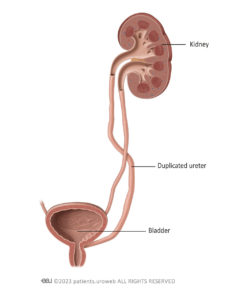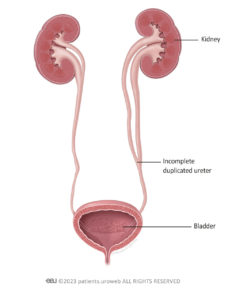What is duplex kidney?
Duplex kidney is another term for ureteral duplication (pronounced ‘yur-eet-eral dew-plik-ay-shun’). This is where a child has 2 ureters (instead of one) connected to a single kidney. The extra ureter may be completely separate (this is called complete duplication), or start separately but combine with the original ureter before it attaches to the bladder (this is called incomplete duplication).
Urinary tract differences are rare, but the most common type is duplex kidney, which affects around 0.8% of the population. The majority of children with this condition have no symptoms and do not experience any related problems, so both the child and parents are very often unaware of the condition.
What are the symptoms of duplex kidney?
While many children with duplex kidney may not have any symptoms at all, some may experience urinary tract infections (UTIs) or urinary incontinence.
In cases of duplicated ureters, up to 20% of children may experience vesicoureteral reflux (VUR) (pronounced: ‘vessy-co-yur-eet-er-ral ree-flux’), which is where urine flows from the bladder, back up the ureter to the kidney. This results in a higher risk of UTIs because VUR slows the flow of urine and causes bacteria to be carried back up the urinary tract, instead of being passed out of the body in the urine via the urethra (wee tube). This can cause bladder or kidney infections.
Symptoms of a UTI include a burning sensation while weeing, having to go to the bathroom to wee a lot (UTIs can make you feel as though you need to wee all the time), cloudy or foul-smelling wee, and pain in the abdomen.
However, in young children and infants, identifying a UTI can be more challenging as they may not be able to describe their symptoms. Often, the main symptom is a sudden high fever without any accompanying problems. Alternatively, you may notice your child is more irritable or doesn’t want to eat as much as usual.
Urinary incontinence means having difficulty holding urine in the bladder. This can lead to your child leaking urine or having an ‘accident’ if they don’t make it to the toilet in time. For children with duplex kidney, urinary incontinence can be a lifelong problem, but this depends on the way in which the ureters (the tubes that connect the kidneys to the bladder) have separated and reattached themselves. Your child’s medical team will be able to explain more about your child’s individual circumstances.
What treatments are available for duplex kidney?
In most cases, no treatment is needed. However, treatment may be considered depending on specific circumstances, such as:
- your child’s age
- your child’s symptoms
- how their urine flows
- their kidney function and their medical history.
Non-surgical Treatments
In over 90% of cases, diagnosis of duplex kidney does not require any treatment. For instance, if it causes no symptoms and does not pose any significant risks. In this situation, your doctor may suggest a “wait and see” approach. This means keeping an eye on things, with regular check-ups so any urinary issues that may arise in the future can be investigated quickly.
If your child keeps getting UTIs because of duplex kidney, your doctor may prescribe antibiotics to kill the bacteria causing the infection. Curing the infection also addresses any discomfort your child may be feeling from the UTI.
Surgical Treatments
Whether or not surgery is needed depends on your child’s individual circumstances and what their medical team recommends. The treatment options offered to you might be different depending on where in Europe you live, as healthcare practices differ between countries. Your doctor will discuss your child’s medical condition with you and will present you with the available and recommended treatment options, so you can make an informed decision.
If surgery is a recommended option, your doctor may discuss some, or all, of the following procedures with you:
- Ureteral re-implantation
- Nephrectomy (pronounced: ‘neff-rec-tomee’)
- Ureteroureterostomy (pronounced: ‘yur-reet-ero-yur-reet-er-ost-omee’)
These types of surgery are carried out under general anaesthesia. This is where your child is given medication to send them to sleep. Once they are asleep, they do not feel anything, nor will they remember the operation.
After the procedure, your child will be taken to the recovery area and closely monitored. Your healthcare team will provide instructions on wound care, pain management and any potential dietary or activity restrictions. It’s important to follow these instructions so that your child has a good recovery.
Ureteral re-implantation surgery involves moving the ureter (or both ureters) from its incorrect position and reconnecting it in the right place so that urine can flow freely through the urinary tract and in the right direction. This procedure is used to treat blockages as well as vesicoureteral reflux.
Nephrectomy (pronounced ‘neff-rec-tomee’) involves the removal of a kidney, or in cases of duplex kidneys, a part of a kidney (partial nephrectomy). However, it is not commonly carried out in cases of duplex kidney.
Nephrectomy may be considered in cases where one kidney is non-functioning and if not removed, could harm your child’s overall health. A partial nephrectomy may be considered if a problem is found in a particular section of a kidney. In this situation, the goal would be to fix the problem while saving as much healthy kidney tissue as possible.
Ureteroureterostomy (pronounced:‘yur-reet-ero-yur-reet-er-ost-omee’) is a reconstructive surgical procedure where the duplicated (additional) ureters running down from the kidney or kidneys are connected to each other. It is usually performed in specific cases where there is a need to redirect the flow of urine.



